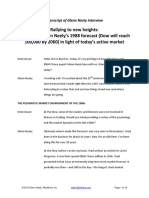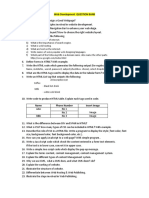DT Time Band
Uploaded by
anudoraDT Time Band
Uploaded by
anudoraDynamic Trader Software Example – Sept.
1999 - Page1
Dynamic Trader’s Time Bands
Dynamic Trader’s Time Bands
Time Bands is a new routine in Dynamic Trader Version 3. DT3 allows the user
to quickly determine the recent time rhythm of a market and enter the time counts
in a table that may be used as long as that time rhythm continues. The Time Band
routine takes the same approach as the Time Rhythm Zone routine that has been
included in the program since Version 1 except the new Time Band routine is
more flexible for short-term analysis and trading strategies.
If you are not familiar with the Time Band approach to projecting high-
probability periods for trend reversal tops and bottoms, go to this month’s Traders
Education Tutorial by clicking here then return to this page.
Here are the steps using DT3 to set-up the Time Band projection routine:
1. Mark off a recent sequence of high or low pivots. DT3 will show you the
bar counts between each pivot.
2. Note the shortest and longest bar count.
3. Enter the bar count range in the Time Band table.
4. If projecting the Time Band target for the next low, place the cursor on the
most recent pivot high.
5. A Time Band bar and the actual beginning and ending dates of the Time
Band range will be displayed in the indicator window.
6. Since the Time Band counts have been saved to a table, the Time Bands
may quickly be projected from any future high and low. The recent time
rhythm will usually continue until the major trend of the market changes or
accelerates.
The chart on the following page shows the Time Band projections for a recent
period for bonds.
Copyright 1999, Dynamic Traders Group, Inc. – www.dynamictraders.com
Dynamic Trader Software Example – Sept. 1999 - Page2
Dynamic Trader’s Time Bands
Below is the Time Band Table. Unfortunately, the screen capture of the table
could not be reduced to properly fit on the Web page so you will have to scroll
side to side to see the whole table.
To keep things simple for this example, only the low-low counts have been
included. The user may also enter the high-low counts. For more information on
how to use the low-low and high-low counts to project the overlap period, see the
Time Rhythm Zone section in the Dynamic Trading book.
As long as the market continues the time rhythm, all a DT3 user has to do is
check on which row in the table is applicable and DT3 will place the Time Band
in the window along with the beginning and ending dates.
Copyright 1999, Dynamic Traders Group, Inc. – www.dynamictraders.com
Dynamic Trader Software Example – Sept. 1999 - Page3
Dynamic Trader’s Time Bands
Time Bands are most effective for relatively short-term cycles. Time Bands may
be used as part of a short-term trading strategy or as set-ups to enter in the
direction of the trend for longer term trades.
The chart below shows the low-low Time Band on bond 80-minute data.
Copyright 1999, Dynamic Traders Group, Inc. – www.dynamictraders.com
Dynamic Trader Software Example – Sept. 1999 - Page4
Dynamic Trader’s Time Bands
The new Time Band routine was developed for DT3 as a quick and easy method
to project the high probability time zones for short-term highs and lows. The Time
Band routine was influenced by Walter Bressert's work who uses a similar
method in his trading approach of cycles and oscillators. For more information on
Walt Bressert, go to www.walterbressert.com. The main difference between how
Walt uses Time Bands and we use them in Dynamic Trader is we use the actual
time rhythm of the most recent market activity rather than average cycle-bands
calculated from long term historical data. Followers of Walt’s work who use
Dynamic Trader Version 3 may enter and save his cycle-band ranges in the Time
Band table.
The Time Band routine in Dynamic Trader Version 3 is another example of how
Dynamic Trader provides the most complete and flexible time analysis and
trading strategy routines and reports of any technical analysis program.
Return Next Month To See How We Use Time Bands To Enter Trades
Why is the Time Band placed in the indicator window? Next month’s Traders
Education Tutorial will teach you how to use a combination of trend direction,
Time Bands and an indicator as a hook to enter a trade with minimum capital
exposure. Be sure and return to the Traders Education and Dynamic Trader
Software example pages the first week of Oct. for more examples of practical
trading strategies with Dynamic Trader.
Copyright 1999, Dynamic Traders Group, Inc. – www.dynamictraders.com
You might also like
- Oracle Database Administration I Exam Number: 1Z0-082100% (2)Oracle Database Administration I Exam Number: 1Z0-08225 pages
- Pattern, Price and Time: Using Gann Theory in Technical AnalysisFrom EverandPattern, Price and Time: Using Gann Theory in Technical AnalysisNo ratings yet
- MARKET TIMING FOR THE INVESTOR: Picking Market Tops and Bottoms with Technical AnalysisFrom EverandMARKET TIMING FOR THE INVESTOR: Picking Market Tops and Bottoms with Technical Analysis2/5 (2)
- Mastering Trading Indicators & Oscillators: Strategies for Success with ATR, CCI, DeMarker, Bulls Power, and Bears Power: Trading Indicators & OscillatorsFrom EverandMastering Trading Indicators & Oscillators: Strategies for Success with ATR, CCI, DeMarker, Bulls Power, and Bears Power: Trading Indicators & OscillatorsNo ratings yet
- Cycle Analytics for Traders: Advanced Technical Trading ConceptsFrom EverandCycle Analytics for Traders: Advanced Technical Trading ConceptsNo ratings yet
- Investment Educators: Free Charting LessonNo ratings yetInvestment Educators: Free Charting Lesson2 pages
- Dynamic Trader Daily Report: Initial Stop PlacementNo ratings yetDynamic Trader Daily Report: Initial Stop Placement6 pages
- Follow Fibonacci Ratio Dynamic Approach in TradeNo ratings yetFollow Fibonacci Ratio Dynamic Approach in Trade4 pages
- 38 - PDFsam - 57602203 Bressert Walter The Power of Oscillator Cycle CombinationsNo ratings yet38 - PDFsam - 57602203 Bressert Walter The Power of Oscillator Cycle Combinations12 pages
- The Isolation Approach To Elliott Wave Analysis: by Steve GriffithsNo ratings yetThe Isolation Approach To Elliott Wave Analysis: by Steve Griffiths6 pages
- Dynamic Trader Daily Report: Protective Stop AdjustmentNo ratings yetDynamic Trader Daily Report: Protective Stop Adjustment5 pages
- Pasavento Instructions For Zup Pattern IndicatorNo ratings yetPasavento Instructions For Zup Pattern Indicator13 pages
- Intelligent Stock Trading System by Turning Point Confirming and Probabilistic ReasoningNo ratings yetIntelligent Stock Trading System by Turning Point Confirming and Probabilistic Reasoning8 pages
- John Hill - Scientific Interpretation of Bar ChartsNo ratings yetJohn Hill - Scientific Interpretation of Bar Charts70 pages
- Dynamic Trader Daily Report: Protective Stop Adjustment On CopperNo ratings yetDynamic Trader Daily Report: Protective Stop Adjustment On Copper5 pages
- The U.S. Stock Market Correlated With The Phases of The MoonNo ratings yetThe U.S. Stock Market Correlated With The Phases of The Moon7 pages
- Curtis Arnold's PPS Trading System - A Proven Method For Consistently Beating The Market (PDFDrive)100% (1)Curtis Arnold's PPS Trading System - A Proven Method For Consistently Beating The Market (PDFDrive)258 pages
- Transcript Discussing Glenn Neely's 1988 ForecastNo ratings yetTranscript Discussing Glenn Neely's 1988 Forecast18 pages
- Market Geometry Basic Monthly Statistics SheetNo ratings yetMarket Geometry Basic Monthly Statistics Sheet6 pages
- Cynthia Kase - Multi-Dimensional Trading PDFNo ratings yetCynthia Kase - Multi-Dimensional Trading PDF3 pages
- Detailed April Crude Oil Update (14 March)No ratings yetDetailed April Crude Oil Update (14 March)4 pages
- Forex Wave Theory: A Technical Analysis for Spot and Futures Curency Traders: A Technical Analysis for Spot and Futures Curency TradersFrom EverandForex Wave Theory: A Technical Analysis for Spot and Futures Curency Traders: A Technical Analysis for Spot and Futures Curency TradersNo ratings yet
- Docs Python Telegram Bot Org en v12.1.1No ratings yetDocs Python Telegram Bot Org en v12.1.1254 pages
- Instrumentarium Dental Focus X-Ray Unit - Changing Tube Head InstructionsNo ratings yetInstrumentarium Dental Focus X-Ray Unit - Changing Tube Head Instructions14 pages
- Banking and Insurance Law Assignment (Abhinav)No ratings yetBanking and Insurance Law Assignment (Abhinav)18 pages
- Function Introduction : Operation Instructions For The Cloning Function For 4 Generation Gearbox of Mercedes-BenzNo ratings yetFunction Introduction : Operation Instructions For The Cloning Function For 4 Generation Gearbox of Mercedes-Benz12 pages
- Sample Technical Report: Measurement and ErrorNo ratings yetSample Technical Report: Measurement and Error10 pages
- Swissbit Part Number - The Dna of Your Specific ProductNo ratings yetSwissbit Part Number - The Dna of Your Specific Product1 page
- Oracle Database Administration I Exam Number: 1Z0-082Oracle Database Administration I Exam Number: 1Z0-082
- Pattern, Price and Time: Using Gann Theory in Technical AnalysisFrom EverandPattern, Price and Time: Using Gann Theory in Technical Analysis
- MARKET TIMING FOR THE INVESTOR: Picking Market Tops and Bottoms with Technical AnalysisFrom EverandMARKET TIMING FOR THE INVESTOR: Picking Market Tops and Bottoms with Technical Analysis
- Thesis On Use of Vectors in Financial GraphsFrom EverandThesis On Use of Vectors in Financial Graphs
- Mastering Trading Indicators & Oscillators: Strategies for Success with ATR, CCI, DeMarker, Bulls Power, and Bears Power: Trading Indicators & OscillatorsFrom EverandMastering Trading Indicators & Oscillators: Strategies for Success with ATR, CCI, DeMarker, Bulls Power, and Bears Power: Trading Indicators & Oscillators
- Cycle Analytics for Traders: Advanced Technical Trading ConceptsFrom EverandCycle Analytics for Traders: Advanced Technical Trading Concepts
- Dynamic Trader Daily Report: Initial Stop PlacementDynamic Trader Daily Report: Initial Stop Placement
- 38 - PDFsam - 57602203 Bressert Walter The Power of Oscillator Cycle Combinations38 - PDFsam - 57602203 Bressert Walter The Power of Oscillator Cycle Combinations
- The Isolation Approach To Elliott Wave Analysis: by Steve GriffithsThe Isolation Approach To Elliott Wave Analysis: by Steve Griffiths
- Dynamic Trader Daily Report: Protective Stop AdjustmentDynamic Trader Daily Report: Protective Stop Adjustment
- Intelligent Stock Trading System by Turning Point Confirming and Probabilistic ReasoningIntelligent Stock Trading System by Turning Point Confirming and Probabilistic Reasoning
- John Hill - Scientific Interpretation of Bar ChartsJohn Hill - Scientific Interpretation of Bar Charts
- Dynamic Trader Daily Report: Protective Stop Adjustment On CopperDynamic Trader Daily Report: Protective Stop Adjustment On Copper
- The U.S. Stock Market Correlated With The Phases of The MoonThe U.S. Stock Market Correlated With The Phases of The Moon
- Curtis Arnold's PPS Trading System - A Proven Method For Consistently Beating The Market (PDFDrive)Curtis Arnold's PPS Trading System - A Proven Method For Consistently Beating The Market (PDFDrive)
- Millard on Channel Analysis: The Key to Share Price PredictionFrom EverandMillard on Channel Analysis: The Key to Share Price Prediction
- Forex Wave Theory: A Technical Analysis for Spot and Futures Curency Traders: A Technical Analysis for Spot and Futures Curency TradersFrom EverandForex Wave Theory: A Technical Analysis for Spot and Futures Curency Traders: A Technical Analysis for Spot and Futures Curency Traders
- Instrumentarium Dental Focus X-Ray Unit - Changing Tube Head InstructionsInstrumentarium Dental Focus X-Ray Unit - Changing Tube Head Instructions
- Function Introduction : Operation Instructions For The Cloning Function For 4 Generation Gearbox of Mercedes-BenzFunction Introduction : Operation Instructions For The Cloning Function For 4 Generation Gearbox of Mercedes-Benz
- Swissbit Part Number - The Dna of Your Specific ProductSwissbit Part Number - The Dna of Your Specific Product




































































































